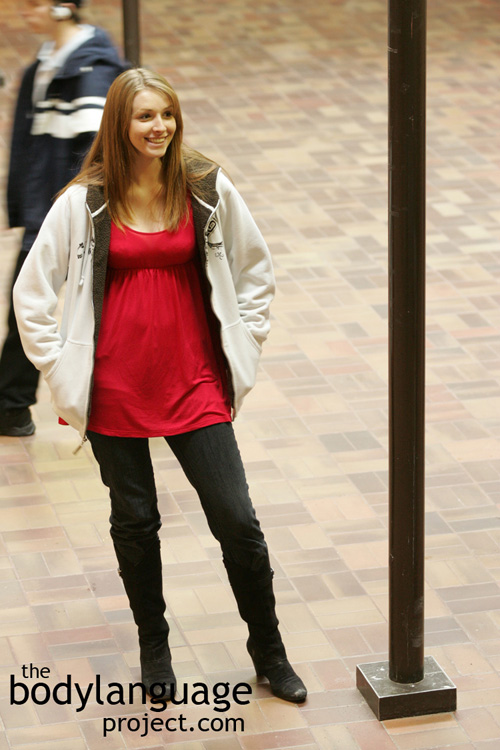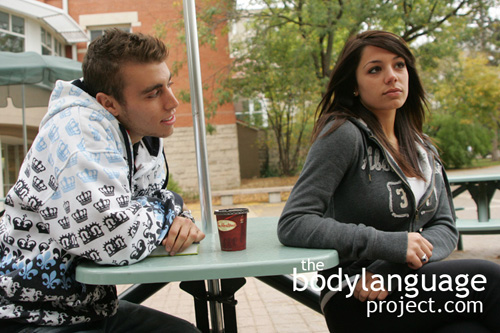Body Language Casual Corner Seating Arrangement
 Cue: Casual Corner Seating Arrangement
Cue: Casual Corner Seating Arrangement
Synonym(s): Kitty Corner, Right Angle Seating, Sitting At The Corner Of The Table, Across The Corner Of The Table.
Description: A seating arrangement where people sit at the corner of rectangular tables.
In One Sentence: The casual corner seating arrangement is defined by sitting across the corners of the table and is a way to maintain separation but also collaborate.
How To Use it: Use the casual corner seating arrangement when you want to provide a client with some privacy but also want to be relatively intimate. This is effective when working on a project that requires independent thought such as brainstorming new ideas or when going over fine details. Friends and family should also meet this way as it is creates a less confrontational feeling.
Context: Social, Business
Verbal Translation: “We sit close to one another in a casual way but still maintain our separation by having the corner of the table between us.”
Variant: The chairs can face forward toward the table reduce eye contact or at angles so as to face the other person directly which is more intimate. See other seating arrangements for variants such as Competitive Head-To-Head Seating Position Arrangement and Cooperative Side-By-Side Seating Arrangement.
Cue In Action: a) When meeting to discuss the acquisition of a new business, the partners sat at the corner of the table to share information and discuss the possibilities amicably. b) When interviewing for the new position, the boss decided to meet over the corner of the table to build comfort and rapport rather than interview in her office across her desk.
Meaning and/or Motivation: Sitting across the corner of the table preserves closeness, but also offers a partial barrier to maintain privacy. This seating position is unique because it allows for independent thought, but the proximity still permits intimacy through closeness rather than aggression and secrecy as with a head-to-head arrangement.
Cue Cluster: We usually see cooperative and engagement cues such as leaning in, business eye contact and head tilted at forty-five degrees to show interest and so forth.
Body Language Category: Barriers, Body pointing, Blading, Orienting reflex or orienting response, Rapport or rapport building, Seating arrangements.
Resources:
Argyle, M., & Dean, I. Eye contact, distance and affiliation. Sociometry, 1965, 28, 289-304.
Beaulieu, Catherine. Intercultural Study of Personal Space: A Case Study. Journal of Applied Social Psychology. 2004 34(4):794-805.
Boucher, Michael L. Holzberg, Jules D. (editor). Effect of seating distance on interpersonal attraction in an interview situation. Journal of Consulting and Clinical Psychology. 1972 38(1): 15-19.
Cook, M. Experiments on orientation and proxemics. Human Relations, 1970, 23, 61-67.
Clack, B., Dixon, J., & Tredoux, C. (2005). Eating together apart: Patterns of segregation in a multi-ethnic cafeteria. Journal of Community & Applied Social Psychology, 15, 1-16. doi:10.1002/casp.787
Castelli, Luigi ; Carraro, Luciana ; Pavan, Giulia ; Murelli, Elisa ; Carraro, Alessia. The Power of the Unsaid: The Influence of Nonverbal Cues on Implicit Attitudes. Journal of Applied Social Psychology. 2012 42(6): 1376-1393.
Coutts, Larrym. ; Ledden, Maribeth. Nonverbal Compensatory Reactions to Changes in Interpersonal Proximity. The Journal of Social Psychology. 1977 102(2): 283-290.
Dolphin, Carol Zinner. Beyond hall: Variables in the use of personal space in intercultural transactions. Howard Journal of Communications. 1988. 1(1): 23-38.
Danielle Jackson, Erika Engstrom and Tara Emmers-Sommer. 2007. Think Leader, Think Male and Female: Sex vs. Seating Arrangement as Leadership Cues. Sex Roles. 57 (9/10): 713-723.
Felipe, N. Interpersonal distance and small group interaction. Cornell Journal of Social Relations, 1966, 1, 59-64.
Felipe, N. Connotations of seating arrangements. Cornell Journal of Social Relations, 1967, 2, 37-44.
Gifford, Robert ; O’Connor, Brian. Nonverbal intimacy: Clarifying the role of seating distance and orientation. Journal of Nonverbal Behavior. 1986 10(4): 207-214.
Gardin, Hershel ; Kaplan, Kalman J. ; Firestone, Ira J. ; Cowan, Gloria A. Lanzetta, John T. (editor). Proxemic effects on cooperation, attitude, and approach-avoidance in a Prisoner’s Dilemma game. Journal of Personality and Social Psychology. 1973. 27(1): 13-18.
Greenberg, J. 1976. The role of seating position in group interaction: a review, with applications for group trainers. Group & Organization Management 1 (3): 310-327.
Greenberg, Carl I. ; Firestone, Ira J. Greenwald, Anthony G. (editor). Compensatory responses to crowding: Effects of personal space intrusion and privacy reduction. Journal of Personality and Social Psychology. 1977. 35(9): 637-644.
Graziano, Michael S.A. and Cooke, Dylan F. Parieto-frontal interactions, personal space, and defensive behavior. Neuropsychologia. 2006. 44(6): 845-859.
Haase, Richard F. ; Dimattia, Dominic J. Berdie, Ralph F. (editor). Proxemic behavior: Counselor, administrator, and client preference for seating arrangement in dyadic interaction. Journal of Counseling Psychology. 1970 17(4): 319-325.
Howells, L. T. and S. W. Becker. 1962. Seating arrangement and leadership emergence.
The Journal of Abnormal and Social Psychology 64(2): 148-150.
Jackson, Danielle ; Engstrom, Erika ; Hassenzahl, David M. Effects of sex and seating arrangement on selection of leader. Perceptual and motor skills. 2005. 100(3 Pt 1): 815-8
Kenner, Andrew N. ; Katsimaglis, George. Gender differences in proxemics: taxi-seat choice. Psychological Reports. 1993 72(2): 625(2).
Leventhal, G. 1978, Sex and setting effects on seating arrangement. Journal of Psychology. 100: 21-26.
Lott, D. F. and R. Sommer. 1967. Seating arrangements and status. Journal of Personality and Social Psychology 7 (1): 90-95.
Michelini, RL, Passalacqua, R., & Cusimano, J. 1976. Effects of seating arrangement on group participation. Journal of Social Psychology. 99: 179-186.
Mackinnon, Sean P. ; Jordan, Christian H. ; Wilson, Anne E. Birds of a feather sit together: Physical similarity predicts seating choice. Personality & Social Psychology Bulletin. 2011 37(7): 879(14).
Norum, G.A., Russo, N.J., and Sommer, R. 1967. Seating patterns and group tasks. Source: Psychology in the schools. 4(3): 276-280.
Newman, Robert C. ; Pollack, Donald Holzberg, Jules D. (editor). Proxemics in deviant adolescents. Journal of Consulting and Clinical Psychology. 1973 40(1): 6-8.
Pease, Barbara and Allan Pease. 2006. The Definitive Book of Body Language Hardcover. Bantam.
Riess, M. and P. Rosenfeld. 1980. Seating preferences as nonverbal communication: a self-presentational analysis. Journal of Applied Communications Research 8(1): 22.
Scherer, S. E., & Schiff, M. R. Perceived intimacy, physical distance, and eye contact. Perceptual and Motor Skills, 1973, 36, 835-841.
Scott, J. A. Comfort and seating distance in living rooms: The relationship of interactants and topic of conversation. Environment and Behavior, 1984, 16, 35-54.
Sommer, R. Studies in personal space. Sociometry, 1959, 22,247-260.
Sommer, R. The distance for comfortable conversation: A further study. Sociometry, 1962, 25, 111-116.
Sommer, R. Personal space: The behavioral basis of design. Englewood Cliffs, New Jersey: Prentice Hall. 1969.
Stephenson, G. M. and B. K. Kniveton. 1978. Interpersonal and interparty exchange: an experimental study of the effect of seating position on the outcome of negotiations between teams representing parties in dispute. Human Relations 31(6): 555-566.
Weiss, M., & Keys, C. The influence of proxemic variables on dyadic interaction between peers. Paper presented at the meeting of the American Psychological Association; Chicago, 1975, August.
Werner, Carol ; Brown, Barbara ; Damron, Gary Steiner, Ivan D. (editor). Territorial marking in a game arcade. Journal of Personality and Social Psychology. 1981. 41(6): 1094-1104.



